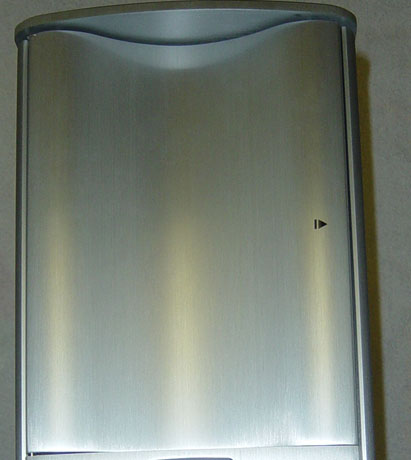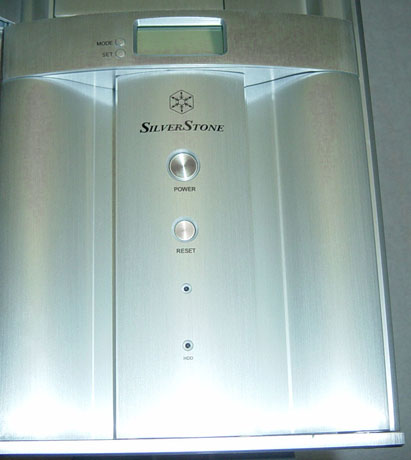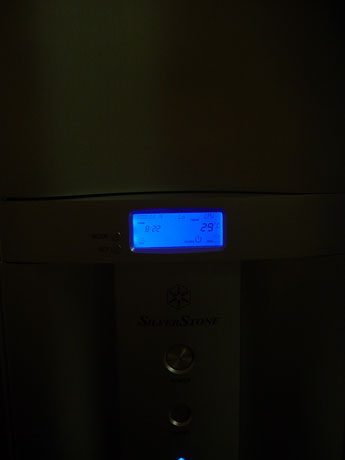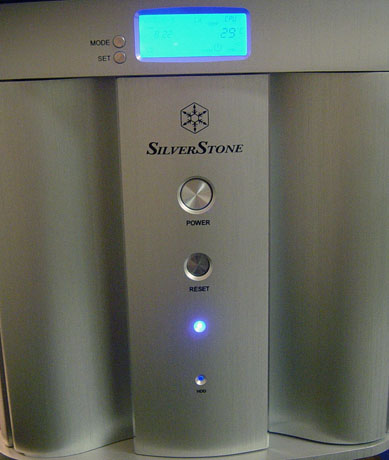SilverStone Technology Temjin 5
by Purav Sanghani on August 25, 2004 12:05 AM EST- Posted in
- Cases/Cooling/PSUs
External Design
SilverStone Technology has taken a different path in designing the look of the TJ05. The TJ03 Nimiz, as well as the 4 previous models in the Temjin line, had a boxy look with straight lines everywhere. The designers at SilverStone veered away from this and added curves to the design of the TJ05's bezel.The top half of the bezel is taken up by the door to the drive bays. This door is what gives the TJ05 its curvaceous look with its convex shape. It was mentioned to us by SilverStone Technology that this was their original design. We have seen this look on the Cooler Master's Wave Master because it was created by the same designer. A small, black arrow graphic (silver model) shows what side the door opens to reduce any confusion.
Behind the door reside the four 5-1/4" drive bays and two external 3-1/2" drive bays. All are covered with matching silver bay covers to carry on the look of the brushed aluminum bezel.
The bottom half of the bezel, which also has a rounded convex shape, is composed of the integrated LCD temperature display, the power and reset buttons, and the power and HDD activity LEDs all in vertical alignment.
The LCD temperature display is one of the simplest, yet most functional, that we have seen in a fully integrated design. Among its features is a date/time display mode, which can be set using the two functional buttons to the left of the display.
The LCD display also shows temperatures for 3 separate components using individual sensors labeled CPU, SYS, and HDD. The alarm function is factory set at 65 degrees Celsius, but can be changed to a custom temperature, again using the two functional buttons. In addition to the alarm mode, the LCD temperature controller adjusts fan speeds automatically depending on temperatures of various components, which is an amazing feature. This gives the TJ05 preventative features to avoid potential hardware damage.
Another feature of the display is the power and HDD activity readout, which functions in the same way the traditional power and HDD activity LEDs do.
Moving on, the power and reset buttons are placed below the LCD temperature display. We noticed that SilverStone has improved these buttons so that they don't stick anymore. In the TJ03 model, the buttons were mounted behind a door, so when pressed, they stuck behind the thin aluminum. In the TJ05, SilverStone designed a deeper tunnel for the buttons in which to slide back and forth, eliminating the sticking problem.
Below the buttons are the power and HDD activity LEDs. They are bright enough to be seen as they were in the TJ03.
















32 Comments
View All Comments
masher - Wednesday, August 25, 2004 - link
Why does the reviewer call a concave door "convex"?JustAnAverageGuy - Wednesday, August 25, 2004 - link
[i] "The TJ03 Nimiz was a monstrous product that had great features, such as a sliding removable motherboard tray, a seemingly endless potential for expandability,"[/i][i] "The Bad
- No removable motherboard tray
"[/i]
?
Modal - Wednesday, August 25, 2004 - link
Wow, that's a really nice looking case. Great review, and thanks for picking a non-ugly case to review this time. :)Almost makes me wish I had waited until now to build my machine... I like that case a lot better than my current one.
ciwell - Wednesday, August 25, 2004 - link
Finally a case that does not burn out your retinas by looking at it. Great review.P.S. Is there a Thermaltake Tsunami Case Review in our near future? :D
Spacecomber - Wednesday, August 25, 2004 - link
I appreciate the inclusion of more pictures showing the case with the components installed. For example, seeing a full size motherboard installed gives me a better feel for the actual dimensions of the case, and I can see how easy it would be to work inside of it. The highlighting of the space between the bottom of the power supply and the motherboard is also important to me, since you sometimes have to worry about CPU heatsinks overhanging the edge of the board, depending on how close to the motherboard edge the socket is placed.Thanks for the review.
Space
skunkbuster - Wednesday, August 25, 2004 - link
at least it looks better than the last one that was reviewed here.oupei - Wednesday, August 25, 2004 - link
page 11, chart units should be "decibels"Operandi - Wednesday, August 25, 2004 - link
Agreed with #1...Deinonych - Wednesday, August 25, 2004 - link
Looks like the author edited the sentence, so n/m.Deinonych - Wednesday, August 25, 2004 - link
#2I agree. In context, it seems like the author meant to say "an entirely ALUMINUM chassis would have appealed more..."